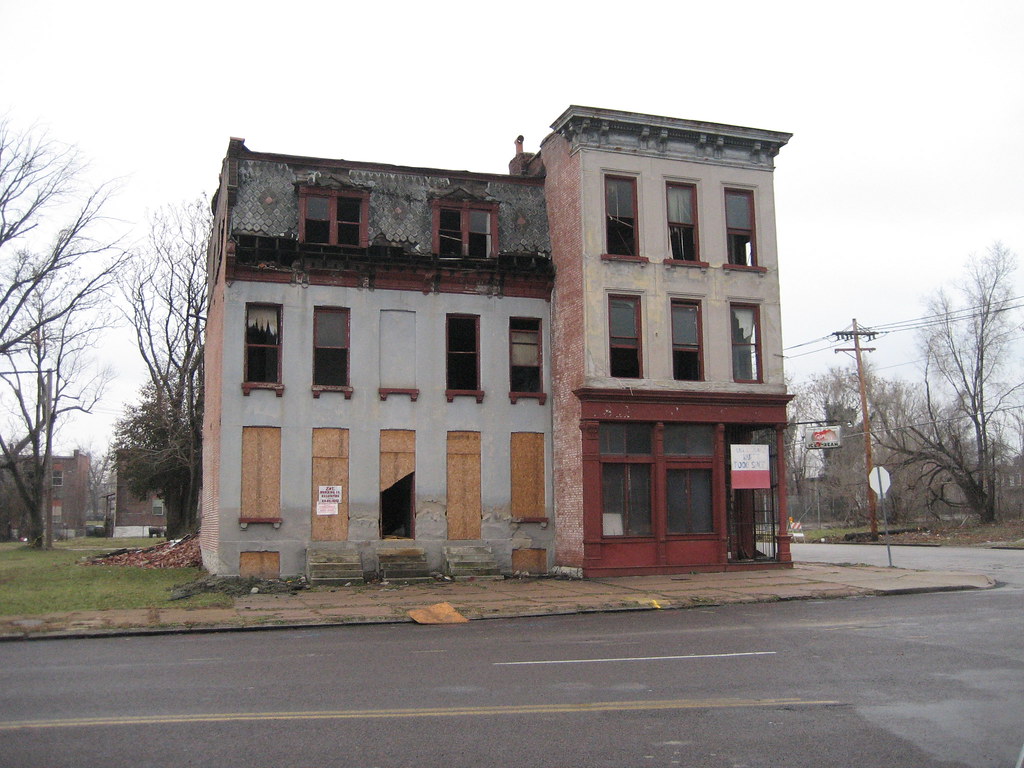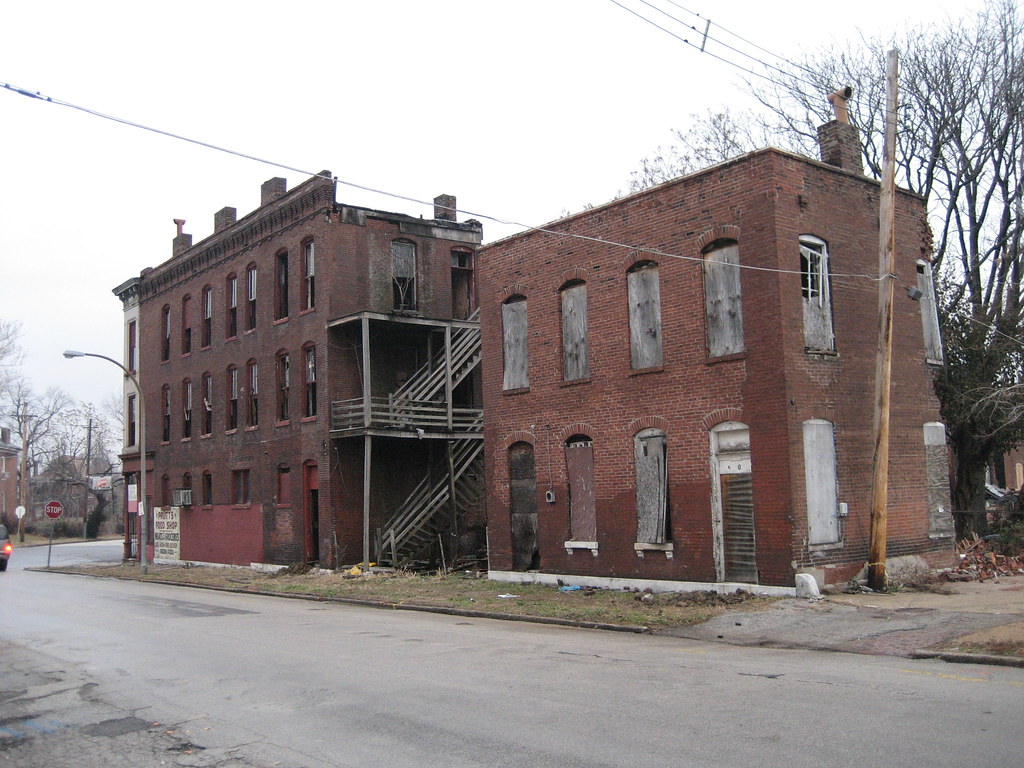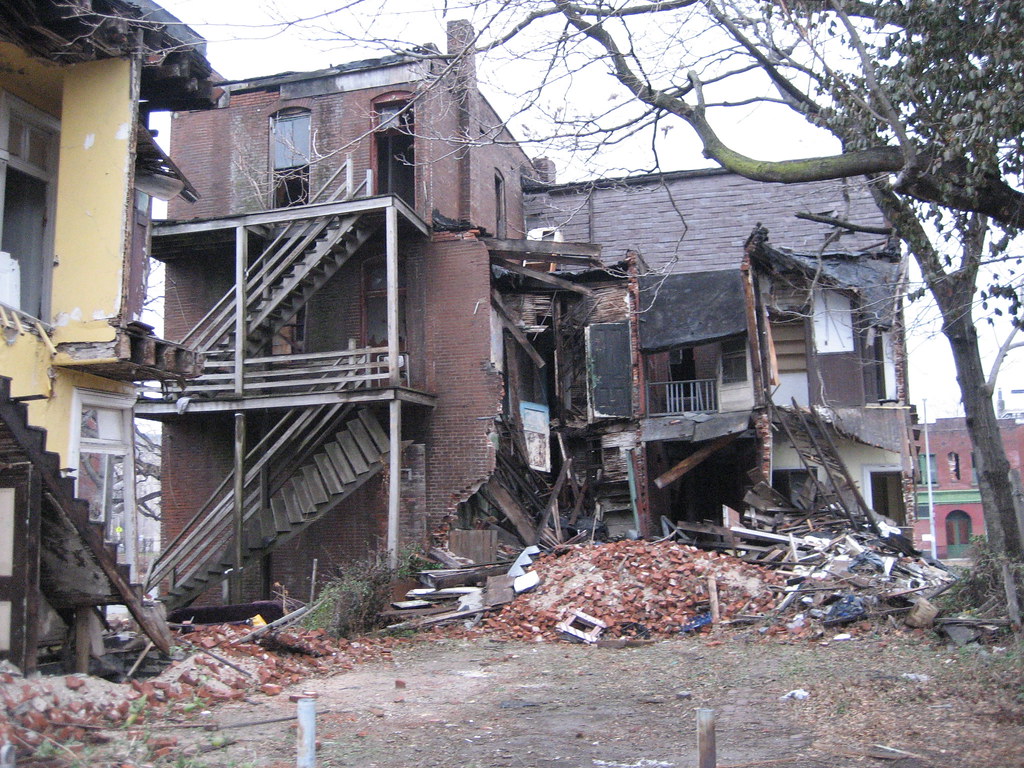
The lovely urban setting shown here (in a photograph contributed by Anthony Coffin) will soon not exist. Shown here, looking south, are the northeast and southeast corners of the intersection of Glasgow and St. Louis Avenues in the city's JeffVanderLou and Lindell Park neighborhoods. The west corners are occupied by historic houses, creating a contrast that is visually arresting without being jarring. The east corners are marked by these commercial buildings -- the iconic, turreted flatiron and the imposing three-story stone-faced mass across the street (subject of a July 2007 blog entry of mine).


Adjacent to the three-story storefront building is an elegant stone-faced tenement building with mansard roof. Behind the storefront building is a flat-roofed two-story alley house -- a vestige of the neighborhoods' historic density. The group is a complementary group of particularly refined examples of old-school St. Louis vernacular forms. Across the street, the flatiron building is almost unparalleled among surviving commercial buildings in north St. Louis. Both the shape and the metal-clad turret (with surviving detail!) are singular. While beautiful in itself, the corner building is dramatized by the fact that it bookends a largely intact row of residences. Whoever designed the corner building understood how to finesse the dynamics of its lot shape and location.


Obviously, the corner and the neighborhood have seen better days. Three out of the four corners here are vacant and owned by holding companies controlled by Paul J. McKee, Jr. After McKee bought these buildings, trouble set in. Last year, knowing that the consequences in north city are low, brick rustlers ravaged the alley house and tenement on the southwest corner. Perhaps the bricks went to a larger brick yard just a few blocks away; perhaps they went to the county. We can be sure that the bricks have long left the city and the state, and that the buildings have since suffered partial collapses.

On December 21, the city's Building Division ordered emergency demolition of the tenement, alley house and storefront at the southeast corner. On December 26, the Building Division ordered demolition of the flatiron and the attached city-owned house to its east. One can see that the tenement was severely damaged and that the alley house was indeed in danger of collapse. But the emergency situation of the two storefront buildings seems to be that they are near the other buildings and the Building Division needs more buildings to demolish.
Sure, the flatiron building has some brick spalling evident, mostly on its St. Louis Avenue elevation where thieves stole decorative brick awhile ago. But where are the public safety issues with it and the other commercial building? Did inspectors go inside of these buildings and find hidden conditions necessitating demolition? Or are we seeing the careless attitude that continues to render north side residents second-class citizens when it comes to historic preservation?
Looking at the details of these fine buildings is heartbreaking. The flatiron's storefront, with corner entrance to store and punctuating brick arched entrance to the stairs, is odd. The metalwork on the turret shows sharp detail over 100 years after fabrication and painting. The slight height difference between the other commercial building and tenement along with the tenement's setback accentuates the corner building perfectly. Intact wooden cornice details on this pair draw the eye upward. One could spend hours looking at these buildings -- and must do so soon. These photographs date to last week; the alley house is completely gone as of this writing. Your tax dollars are, as they say, at work.
Here are links to the demolition permits:
2845 St. Louis Avenue (flatiron)
2854 St. Louis Avenue (tenement)
2858 St. Louis Avenue (commercial building and alley house)
(All photographs by Anthony Coffin; more here.)





9 comments:
Question -- do we have a new building division head? Seems like demos of structurally sound buildings are accelerating, especially where the demo would be advantageous to well-connected businesspeople (including, but not limited to, a certain wealthy St Charles developer.) We've had several new condemnations in ONSL of structurally sound buildings, and there have also been those "emergency collapse" situations where 6 bricks have fallen off a parapet next to a vacant lot, and your average northsider could fix this shocking catastrophe with a ladder, a bucket of mortar and a butter knife. Where is that ordinance we were going to get from the Alders where absentee owners with multiple flagrant scofflaw violations would be forced to maintain or forfeit their property, not just pay a fine.
According to the wreckers the storefront and the building with the mansard roof are being demolished today. They are waiting on a bulldozer. I took photos today. The flatiron is supposed to be demolished next week.
what a disaster. Even this small assemblage of buildings at the corner could be the beginning of a small spark in the larger north area, but seeing the 2 mostly intact building across the street is just disheartening.
The corner building was an active storefront in excellent condition just a little more than a year or so ago, (ie before McKee bought it) If the previous owners could be contacted or neighborhood individuals who frequented this store identified I would hope the Post or some news outlet would do a follow up on McKees holdings and his lack of upkeep. There should be a city lawsuit against this guy.
I have seen so much of this over the years I am numb.
Beyond public concern voiced through the local media, I don't know of any other way to compel a developer or land owner who hasn't submitted proposed plans for new work to reveal any plans for their privately owned land. Is anyone aware of any sort of stipulation that would require a developer seeking this land ssemblage tax credit to indicate intent?
Look for more emergency demolitions to be declared in the ward - under aldermanic pressure the last few shells, partially demolished by brick thieves along the 1900 block of Wright, may soon be declared emergency demos as well
You mean "partially demolished by brick thieves" ... acting with the tacit approval of owner Paul McKee, who has signalled his indifference to community mores by taking steps to encourage brick theft. Steps like failing to lock the doors or board the buildings, failing to respond over a MULTI-YEAR period to neighbors who call to alert him that brick thieves have entered the building and are doing taps. Even when said neighbors have pictures, license plates and have already created police reports of this activity.
What Progress!!!!
I'm sorry, that should have said, what a damned shame.
Not that some people know the difference.
This is just the type of remnant to which smaller developers can relate new infill construcion. Clearly the developer has no preservation in his agenda, but further likely wants to clear as many of the extant locals from the area as he can. A scorched earth upon which he can build suburban form development. I would hope the city would at least have the usefulness to host some design competitions for the vast expanse of desolation, because there is so much work to be done. My feeling is that they will wait until McKee gets his 50% off land purchase rebate from the state, and his initial offerings will then set the pattern for other, likely out-of-state corporate developers to march alongside him in the parade of low-density suburban crap. Someone on Urban Review had mentioned earlier that he thought large portions of north St. Louis would be home to trucking warehouses and other light industrial occupancies. I believe those with power and money see the vastness as land 'nobody' wants, and the city, in its desperation for at least visible development (if not tax revenue)to offset the negative perception associated with urban decay, are willing and pliable enough to give carte blanche to those with power and money.
Post a Comment